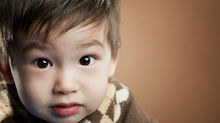This little piggy went to market.....
- Carri Kasick

- Jun 12, 2017
- 3 min read

Sensory Social Routines and Increasing the Fun Quotient The more fun your child is having , the longer your child is attending and interacting with you, and the more learning opportunities you can provide.
★ A. Definition: A social play between two people- a kind of social play that promotes touch and gaze, fun and excitement, for both you and your child.
1. Sensory: Often involve stimulating sensory experiences
2. Social: Primary focus of these games is the social experience of another person and not playing with objects, teaching cognitive, and/or other skills
3. Routines: Becoming familiar and ritualized for the child and this is a feature that makes them easier for your child to learn, so the child can quickly learn how to initiate and request these games.
★ B. What we can do to Increase the FUN Quotient!!!!
1. Find the rhythm of the sensory social routine
○ There is a clear rhythm to this---a kind of balanced exchange in which
both partners are engaged, in a back-and-forth manner. You start, you pause, your child cues, you continue, you pause, your child continues, & so on.
2. Build the repertoire and refine the routines ○ To make sure we don’t lose the benefits of SSR’s, be alert for the need to
add to your repertoire, promote your child’s participation as a full partner, vary the routine enough to keep it interesting, pick the best times and settings. (Early signs that a child is losing interest during a SSR include lessened responding in between your pauses, looking away during your turns, and changing his body language- active to passive)
3. Optimize your child’s energy level for learning ○ Children who are over aroused and underaroused are not in an ideal
state for learning. Optimal learning occurs when a child is alert, attentive, and engaged- not when he is passive, spaced out, tired, or when he is over excited, agitated, or overly aroused and out of control. Take steps to identify and optimize your child’s arousal level for learning.
Sensory Social Games to Consider
1) Make raspberry noise with your lips
2) Blow raspberries on your child’s feet, hands, or belly
3) Kissy face and kissy noises
4) Fish lips
5) Hide your face in peekaboo
6) Whistle
7) Blow cheeks up and pop your cheeks
8) Blow a pretend candle
9) Make a train whistle sound
10) Talk out the side of your mouth
11) Winkquickly
12) Make a soft to loud humming sound
13) Sing nursery rhymes
14) Hold child’s feet in front of your face and play peek a boo
15) Saying “aahh” from soft to loud and low to high pitch
16) Tile your head back and look up and quickly bring it back in front of child’s face
17) Child on your lap, facing you, and rock back and forth
18) Child on your lap and wiggle your legs to bump them around
19) Child on their back and squeeze their legs as they hold them up to you
20) Raise the child higher than you and have them look down to you
21) Wiggle your tongue in any direction
22) Traditional silly face with tongue in and out quickly
23) Smacking your lips noise
24) Scrunch face tightly and then open eyes wide
25) Clicking noise with tongue
26) Pinch child’s nose and make click noise at the same time
27) Bring hands up high and make a high pitch sound and then hands down low with low
sound
28) Drum roll on different body parts (child’s back, tummy, legs) & drum sound
29) Snorting or snoring sound to pretend sleep and then surprise wake up face
30) Gasping and hands on cheeks
31) Say slowly, “IIII’mmmm goooonnnnaaaa geeeet yooooou”
32) Whisper sounds
33) Make the “sh” sound, pretend to fall asleep, and then wake up
34) Hold fingers up in a tickle gesture and wiggle your fingers towards child
35) Hold up pointer fingers and bend them in and out- gesture to poke child in belly
36) Make an “O” with your mouth and suck air in
37) Lay on your back and put child up on your feet like they are flying
38) Peek a boo with different faces
39) Have child lay on his/her back and move legs in a bicycle motion
40) Make animal sounds






























Comments